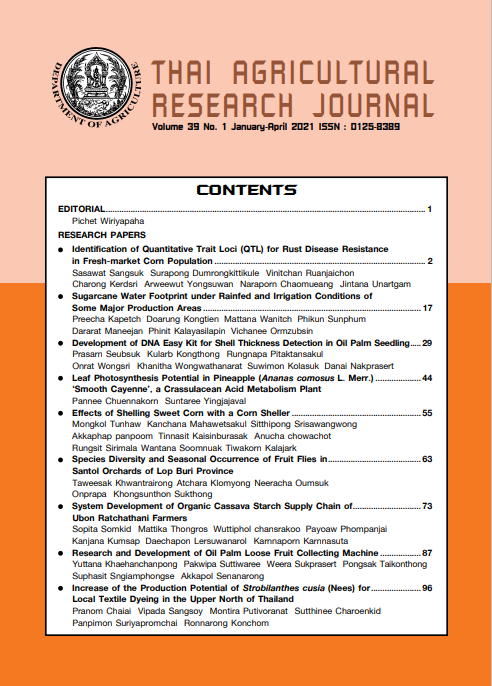Increase of the Production Potential of Strobilanthes cusia (Nees) for Local Textile Dyeing in the Upper North of Thailand
DOI:
https://doi.org/10.14456/thaidoa-agres.2021.9Keywords:
indigo paste, indigo substance, , indigo mixer machineAbstract
Strobilanthes cusia (Nees) (Kuntze) is a shrub that grows in the natural forests of the upper North. It has been widely and popularly used as raw material for dyeing the local textile products and is now in short supply. Phrae Agricultural Research and Development Center has been collecting, conducting cloning comparison and developing S. cusia production technology during 2012-2020. The objectives were to study suitable varieties and production technology in the upper northern region and transferred the information to farmers. Results showed that S. cusia could be classified into 2 groups; the large leaf (Strobilanthes cusia (Nees) Kuntze) and the small leaf (Strobilanthes sp.). The two groups had no different growth. But the large leaf group gave higher fresh yields and indigo substance than the small leaf group. The suitable plant spacing was 50x60 cm from which fresh yield of 1,266 kg/rai was obtained. Seventy percent shading increased fresh yield to 3,315 kg/rai. The harvesting index was 9 months after planting which gave fresh yield of 4,592 kg/rai. Optimal time to harvest was between 7.00-11.00 am which gave 421-463 kg/rai
of indigo plate. When testing the production technology of 10 farmers in Phrae province. It was found that using DOA technology farmers could harvest 4 times/year with fresh yield of 3,844 kg/rai, 769 kg of indigo paste with a unit cost of 7,063 baht, an income of 38,436 baht, and a return profit of 31,373 baht. Using the farmers’ technology the plant could be harvested 2 times, with fresh yield of 1,773 kg/ rai, 355 kg of fresh produce with production cost of 4,909 baht, an income of 17,728 baht, and a net profit of 12,819 baht. These
activities obviously increased farmers and communities income and helped maintain the wisdom into the future.
References
นิตยา ชะนะญาติ. 2544. การพัฒนาการสกัดอินดิโก้จากครามและฮ่อมเพื่อใช้ในการย้อมสีธรรมชาติ. วิทยานิพนธ์ ปริญญาวิทยาศาสตรมหาบัณฑิตสาขาวิชาเทคโนโลยีชีวภาพ. บัณฑิตวิทยาลัย มหาวิทยาลัยเชียงใหม่. 77 หน้า.
ประนอม ใจอ้าย วิภาดา แสงสร้อย สนอง อมฤกษ์ พัชราภรณ์ ลีลาภิรมย์กุล ฉัตรสุดา เชิงอักษร สากล มีสุข นิพัฒน์ สุขวิบูลย์ และอุทัย นพคุณวงศ์. 2558. การเพิ่มประสิทธิภาพการผลิตห้อมเพื่อย้อมผ้าในภาคเหนือตอนบน. หน้า 46-50. ใน: เอกสารประกอบการประชุมสัมมนา Year End กรมวิชาการเกษตร ประจำปี 2558. 28-29 กันยายน 2558 ณ โรงแรมรามาการ์เด้นส์ กรุงเทพฯ.
วงจันทร์ วงศ์แก้ว. 2535. หลักสรีรวิทยาของพืช. ภาควิชาพฤกษศาสตร์ คณะวิทยาศาสตร์ มหาวิทยาลัยเกษตรศาสตร์. 157 หน้า.
สถาบันวิจัยวิทยาศาสตร์และเทคโนโลยีแห่งประเทศไทย. 2548. เทคโนโลยีสร้างสรรค์ผลิตภัณฑ์ OTOP เล่ม 4 เทคนิคการย้อมผ้าหม้อห้อมให้มีคุณภาพได้มาตรฐาน. 32 หน้า.
สุรีย์ ฟูตระกูล สรศักดิ์ เหลี่ยวไชยพันธุ์ สุปราณี เสียงใส อนงค์ จีระโสตถิกุล ฐานิศ บุตรเพชรรัตน์ อัฉรา สายหยุด ศิริวรรณ วิชัย และสุรารักษ์ จันทนเสถียร. 2543. การพัฒนาสารย้อมสีธรรมชาติในเขตภาคเหนือตอนบน. สำนักงานกองทุนสนับสนุนการวิจัย. 199 หน้า.
อนันต์ ปินตารักษ์ เพิ่มศักดิ์ สุภาพรเหมินทร์ เศรษฐา ศิริพินทุ์ และพิเชษฐ เวชวิฐาน. 2551. เทคโนโลยีที่เหมาะสมสำหรับพัฒนาการปลูกต้นครามและต้นฮ่อมในสภาพพื้นที่จังหวัดเชียงใหม่และสกลนคร. ภาควิชาพืชไร่ คณะผลิตกรรมการเกษตร มหาวิทยาลัยแม่โจ้. 83 หน้า.
Cramer, L.H. 1998. Acanthaceae, page 1-140. In Dassanayake, M.D. (ed.). A Revised Handbook to the Flora of Ceylon Vol. XII. A.A. Balkema, Rotterdam, The Netherlands.
Das H, Kalita D. 2016. Fibers and dye yielding plants of north East India. In Purkayastha J, editor. Bioprospecting of indigenous bioresources of north-east India. Springer science+business media Singapore. : 77–99.
Shahni, R. and P. J. Handique. 2013. Anti-bacterail Properties of leaf extracts of Strobilanthes cusia (Nees) Kuntze, a rare ethno-medicinal plant of Manipur, India. Int. J.Pharm Tech Res. 5(3): 1281-1285.
Splitstoser J.C., T.D. Dillehay, J. Wouters and A. Claro. 2016. Early pre-Hispanic use of indigo blue in Peru. Sci Adv. 2(9): e1501623.
Taguchi, K., T.Tokano., Y. Yamaoka, and K. Furuse . 2003. Hair dye and hair-dyeing methods using the same. US Patent. Available at: https://patentimages.storage.googleapis.com/dd/1a/19/63ff410198c3e5/US6656229.pdf Accessed: 10 June 2020.
Zarkogianni M., E. Mikropoulou., E. Varella., and E. Tsatsaroni . 2011. Colour and fastness of natural dyes: revival of traditional dyeing techniques. Color Technol. 127(1):18–22.
Downloads
Published
How to Cite
Issue
Section
License
Copyright (c) 2021 Thai Agricultural Research Journal

This work is licensed under a Creative Commons Attribution-NonCommercial-NoDerivatives 4.0 International License.
Thai Agricultural Research Journal



